Enemies Of The Telegraph Pole And Cable
Reprinted from "Crown Jewels of the Wire", November 1991, page 11
Animals, Birds, Fish, and Insects which Destroy the Telegraph
Poles and
Wires, in Different Parts of the World.
Wires are quite harmless objects, whether they be attached to telegraph
poles. or sunk in the bottom of the sea, and they are not in the least striking-looking, either. Nevertheless, they have numerous enemies in the animal, as
well as in the vegetable kingdom.
An American paper recently reported that a newly
erected line, in the woods of Aristook, in North Maine, had been damaged by
black bears, who were in the habit of climbing up the posts and breaking off the
insulators by which the wires are supported.
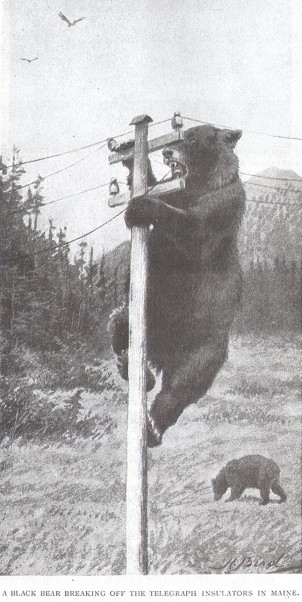
Why Bruin shows such a curious
predilection for these hard unappetizing objects will ever remain a mystery to
us; and as bears are not in the habit of wearing their hearts on their sleeves,
we cannot easily get at their reasons. It has been supposed that the bears
mistake the insulators for the wild apples, of which they are so extremely fond;
at all events it is certain that they consider them as something eatable.
Perhaps they think they are bee-nests.
There is, too, in Norway, a large
woodpecker which, deceived by the buzzing sound somewhat resembling the Ĉolian
harp, which is often emitted by the wires when the wind moves them, evidently
imagines a nest of insects to be inside the post. He sets to work, and searches for them for days together, pecking
large holes in the wooden poles, sometimes even piercing them through, to
discover that the land of Cockayne he hoped to find existed only in his
imagination, and that all his work has been in vain.
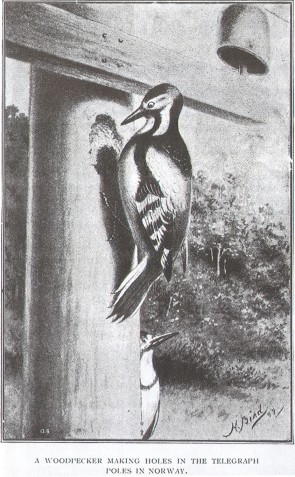
The green woodpeckers
of California are much wiser; these birds use the telegraph-posts of red cedar-wood as store-houses. They make holes in the posts at the top, and fill
them with acorns -- one in every hole -- and in this way provide against starvation..
They undoubtedly show an originality and an ingenuity that does not fall far
short of that peculiar to the American nation. For, except this Yankee
woodpecker, does there exist anywhere a woodpecker so ingenious as to use
telegraph-posts by way of a store-house?
It is a well-known fact that Indian
crows and Australian magpies pick up the small ends of wire left after the line
is made, and make their nests with them on the top of the posts; but in this
matter they are following a natural instinct, and it is impossible to think of
" invention" in this connection.
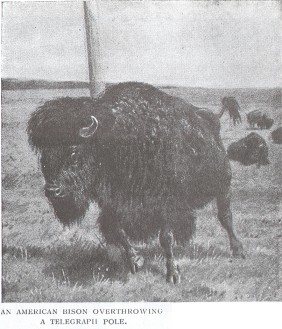
The American bison, too, in his
wanderings over the prairies, shows an ingenuity one would not have given him credit for; he uses the poles as rubbing posts, and
sometimes destroys the line for several miles' length. An American, who wished
to make him discontinue this habit, studded the lower part of the posts with
nails. But the shaggy bull, who did not possess an ordinary curry-comb of his
own, took to the idea of one amazingly, and showed a decided preference for
those posts that were thickest studded with nails.
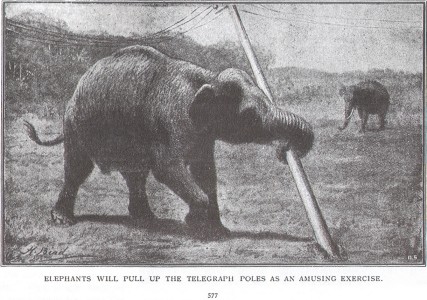
Elephants always have found a
great delight in pulling out telegraph-posts with their trunks by hundreds
together, apparently with no other purpose than to test their strength.
Ants are
only tiny creatures, compared with elephants; but that does not prevent them
being even more formidable foes to the telegraph. In tropical countries white ants,
or termites, devour wooden posts in a very short time; therefore an unfailing
expedient had to be found, and now in regions where these poachers abound,
the telegraph-posts are rubbed with creosote-oil, or, which is even better, are
replaced by iron ones.
In Japan there lives a spider which is a great nuisance
to telegraphists, because it hangs its web from one pole to the other, thereby
causing a disturbance .in the electric current from wire to wire, especially in
the morning, when the webs are heavy with dew.
Wasps and other insects
also build their nests between the wires, or near the insulators, and cause
great disturbances in the conveying of intelligence, whenever the weather is
damp or rainy. Of course, those plants that grow on the wires and posts have the
same deleterious influence, and near Rio-Janeiro the lines are frequently spoiled
by a kind of parasite plant that takes root in the poles. This plant is brought
there, it is said, by seeds which are dropped by birds perching on the wires and
posts.
But after all, human beings are the worst enemies of the telegraph-line.
Not only do boys and thoughtless adults often throw stones at the insulators, or
aim at then with guns, but they sometimes throw paper or rags over them, or
allow their kites to fly against the wires, thereby causing a loss of
electricity. In Belgium it is thought more expedient to use insulators of a
dull grey, that is not easily visible, instead of the white ones, that always
tempt boys to aim at them. In uncivilized countries the aborigines often destroy
the lines if their chiefs are not given a satisfactory amount of "baksheesh,"
or frightened by some superstitious tale concerning the talking"
fetish" of the white man. When Lord Wolseley marched against Coomassie,
his telegraph-line, carried through the woods on bamboo posts, remained intact,
and was not attacked by the enemy. But lest he should be suspected of sorcery,
we must add that the aborigines made a line themselves, a rope fastened to trees.
On the "Macdonald line," in Western Australia, the blacks were made
acquainted with the power of the telegraph, by making them touch the wires at a
moment that they were strongly charged with electricity. Consequently they
received a rather violent shock. This trick was used in several parts of the
world, and always with the best success.
One can understand that weather has
much influence on the lines laid above ground. A high wind will sometimes overthrow them, and frost covers them with a crust of ice that often snaps them.
Wires in tubes underground do not, of course, suffer in this way; but still
they are not quite free from damage, for rats and mice often nibble the gutta-percha
a that covers the brass wire. Underground wires are as often struck
by lightning as those above ground, if they are not effectively protected by
lightning-conductors. Many a pole has been smashed to splinters, and many a
cable melted by lightning. Underground lines also undergo the influence of
what are called "earth-currents" i.e., electric currents in the soil
itself. These currents are, however, seldom sufficiently strong to harm the wires,
though they often disturb the workings of the telegraph. They are especially
influential when atmospheric phenomena take place, as aurora borealis, falling
stars, &c., or when there are sun-spots.
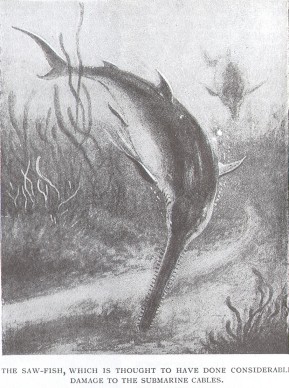
Submarine lines would seem to be
guaranteed against damage, but even they are often molested. The limnaria-worm
and the crustacean destroy the hemp and the gutta-percha that protect the wires,
and these cause the current to escape into the sea. One single meal of the
limnaria-worm has cost the shareholders of a cable-society many thousands; for it is
extremely costly
to have a cable inspected from a ship, and to have the damaged spot repaired,
especially if the weather does not favour the work. The sawfish, that always
rakes up the mud with its long saw-like snout, has often been accused of cutting the cables, but has never
yet been caught in the act. It is a fact, however, that some fish perforate submarine cables, for the writer once took part in a cable-inspection from Para
to Cayenne, and scarcely had the cable been replaced than it was found to be out
of order again. While the tube was being repaired, I saw pieces of teeth
belonging to fish sticking in the gutta-percha. I maintain that the perforations
were actually caused by the bites of fish, but not by the sawing
of a sawfish. The iron wires covering the cable had apparently been cracked by
strong jaws.
Whales have often been entangled and strangled by submarine
cables. A curious example of this happened in the Persian Gulf, when the cable
was taken up, and the ship engaged in repairing it discovered thereon the dead
body of a whale. Mr. Lumsden told me that once, while repairing a cable in the German Ocean, he brought up the wreck of a
small schooner.
It often happens, too, that fishing-boats and other vessels
damage the cables with their anchors, and do not mention the fact. Mr. Hockin,
a well-known engineer, was on board a steamer which, while weighing anchor at
Lisbon, seriously damaged a cable. With his marvelous ingenuity, he got up an
impromptu battery and wired the whole affair to the telegraph-office in town,
thereby saving much time and money to the cable-repairers.
Near the coast and
in river the cables may be harmed by malevolent persons. In the early days of
the telegraph, it frequently happened that the Chinese stole the wires from
the cables to make them into nails.
Jack Hayes of Pakenham, Ontario, sent this terrific article from the 1907
November issue of "The Girl's Realm" magazine. Jack wrote: "An
unusual article for a girl's magazine of the day. It shows that girls have been
interested in the telegraph for a long time. Many of the early operators were
ladies.
I particularly liked the black bear "in Maine" going after
insulators. They don't even look like a beehive style. Maybe the electric shocks
he would get felt like bee stings and therefore expected honey. The wires
probably buzzed as well.
|
